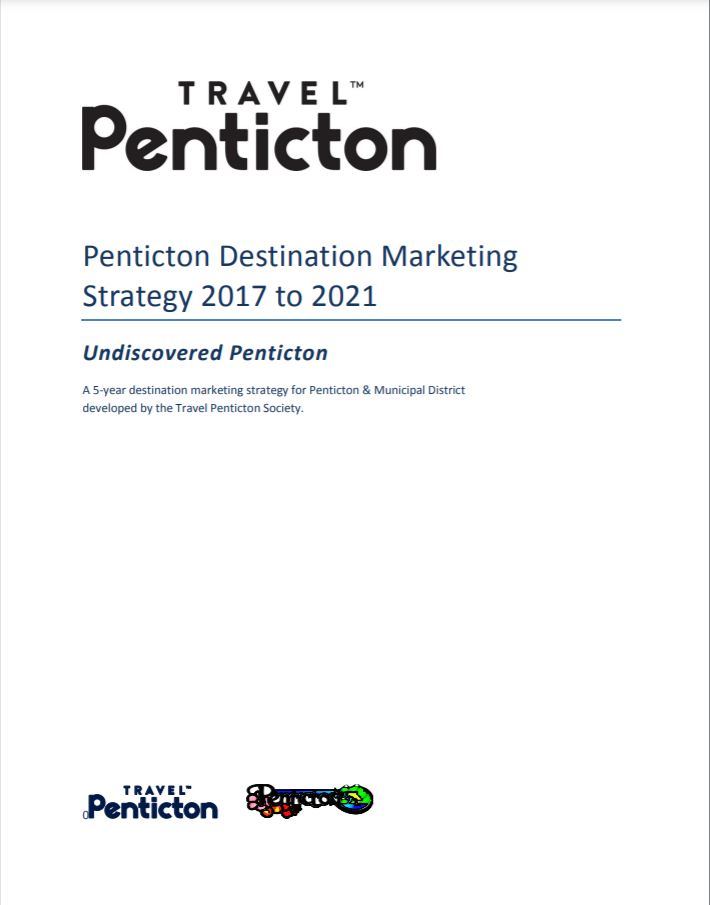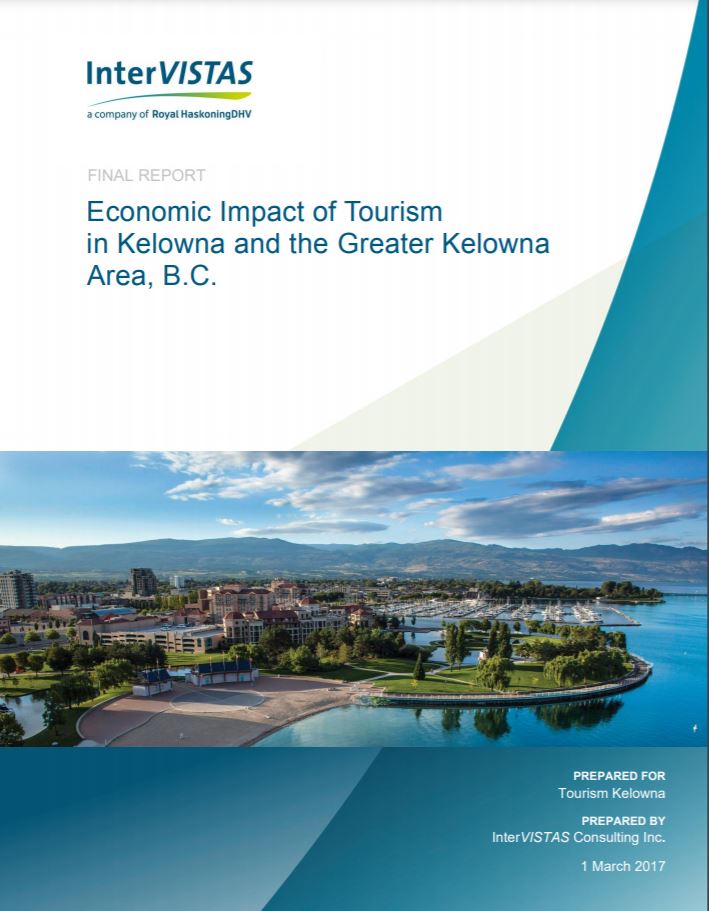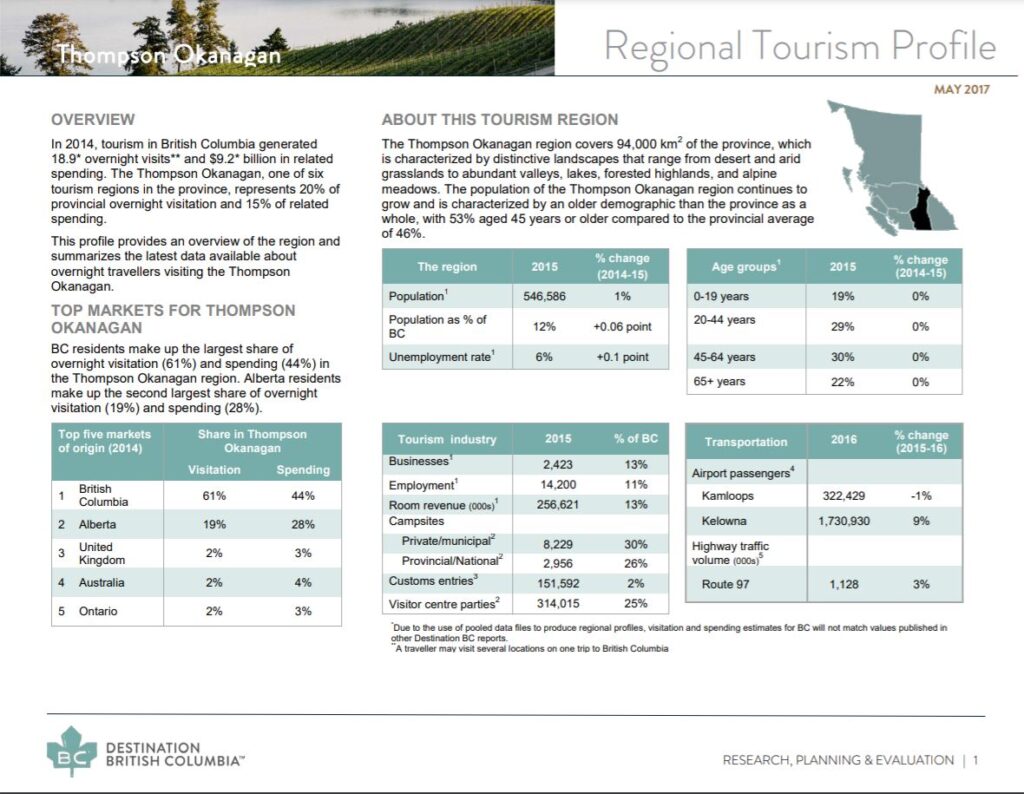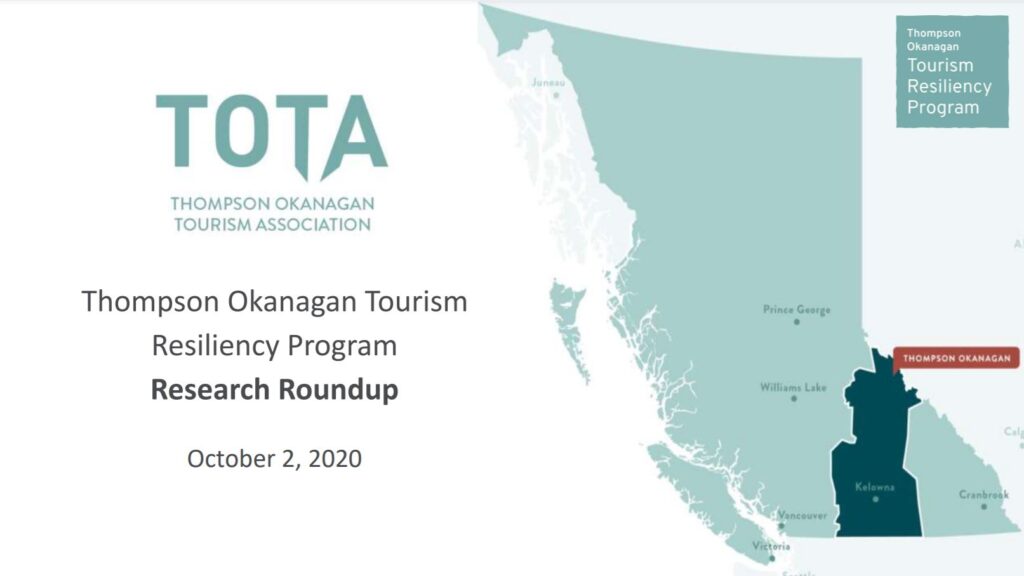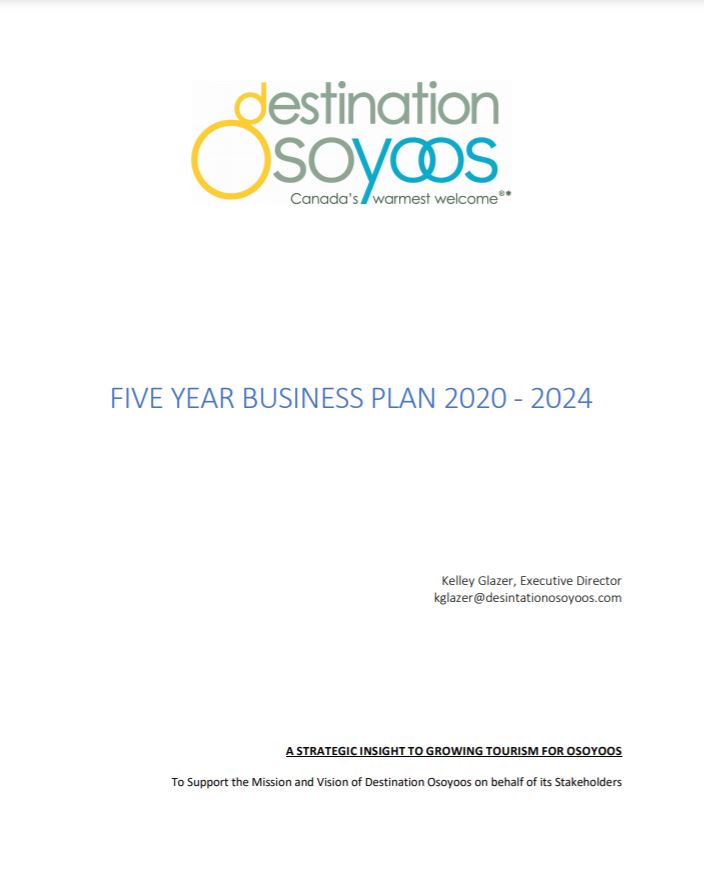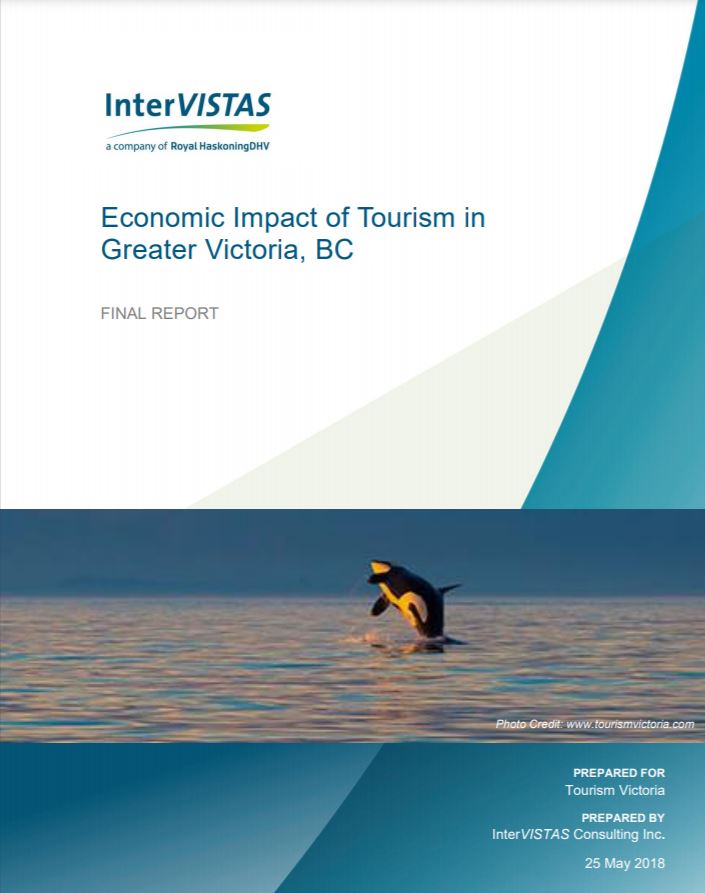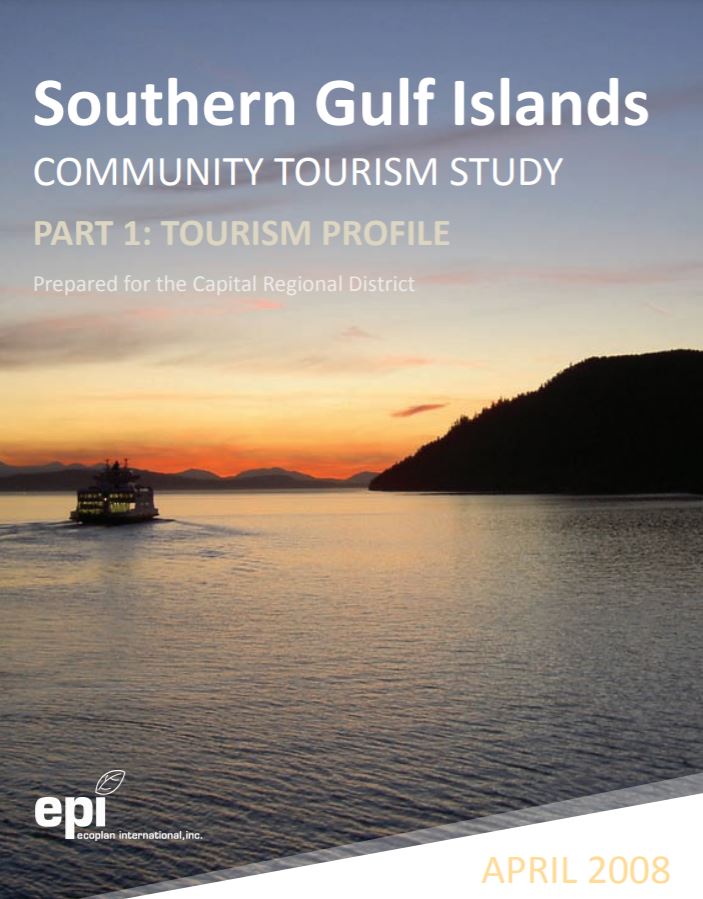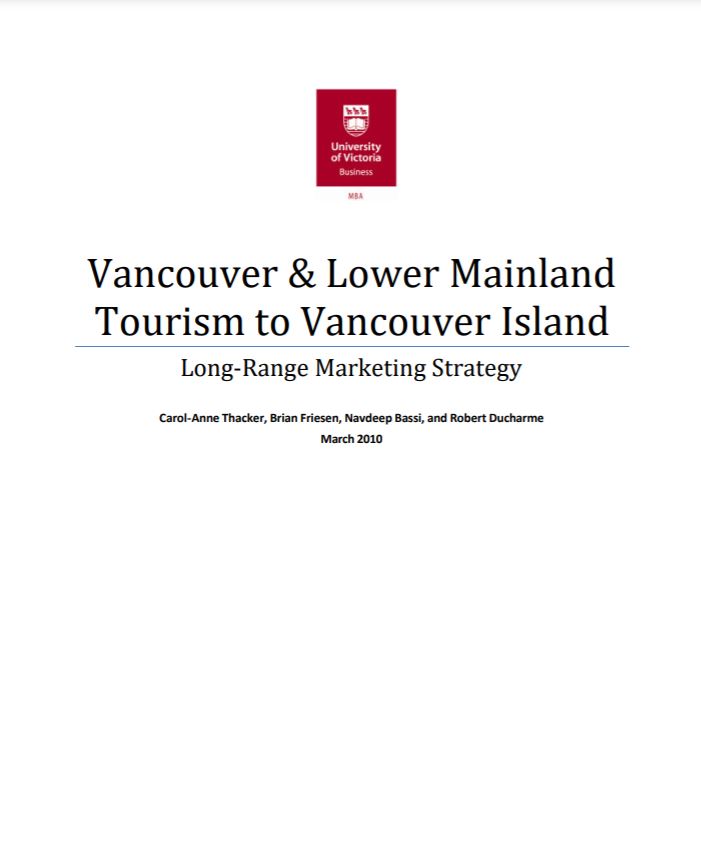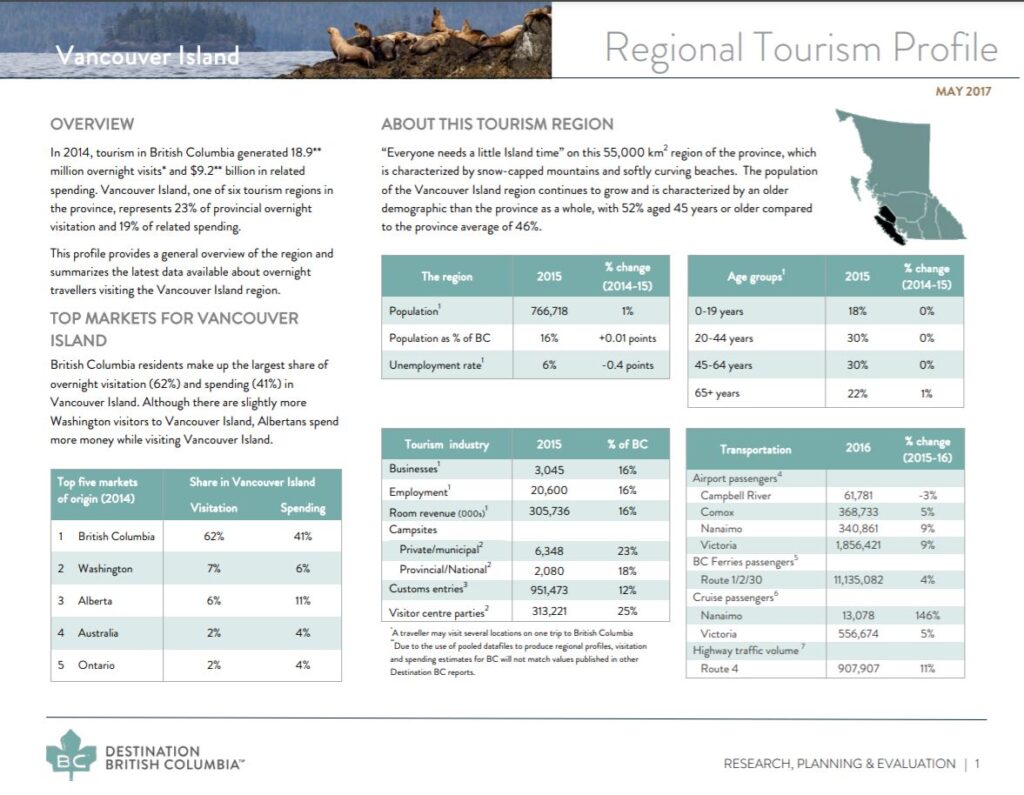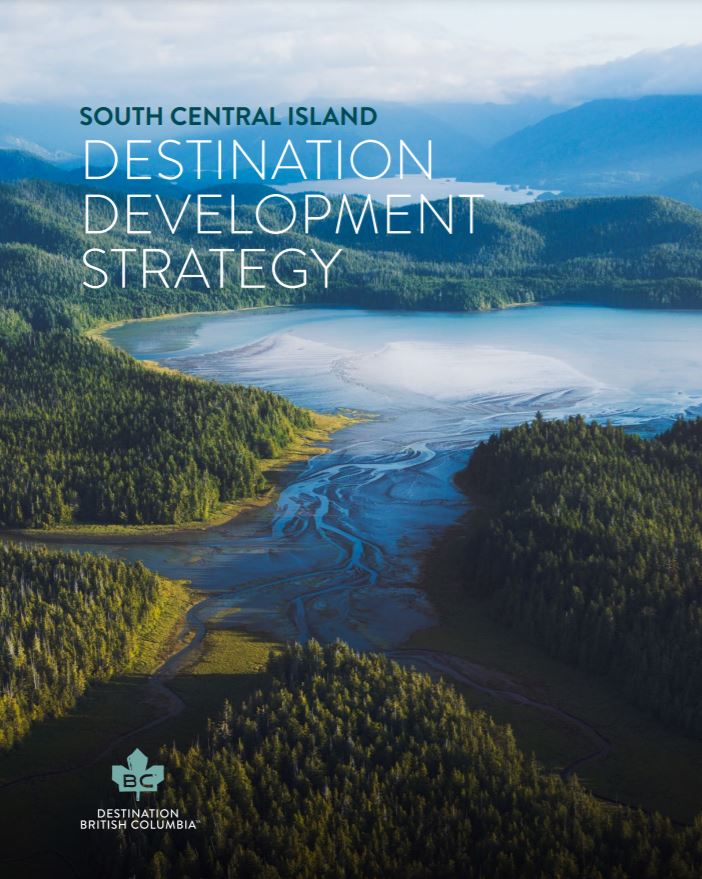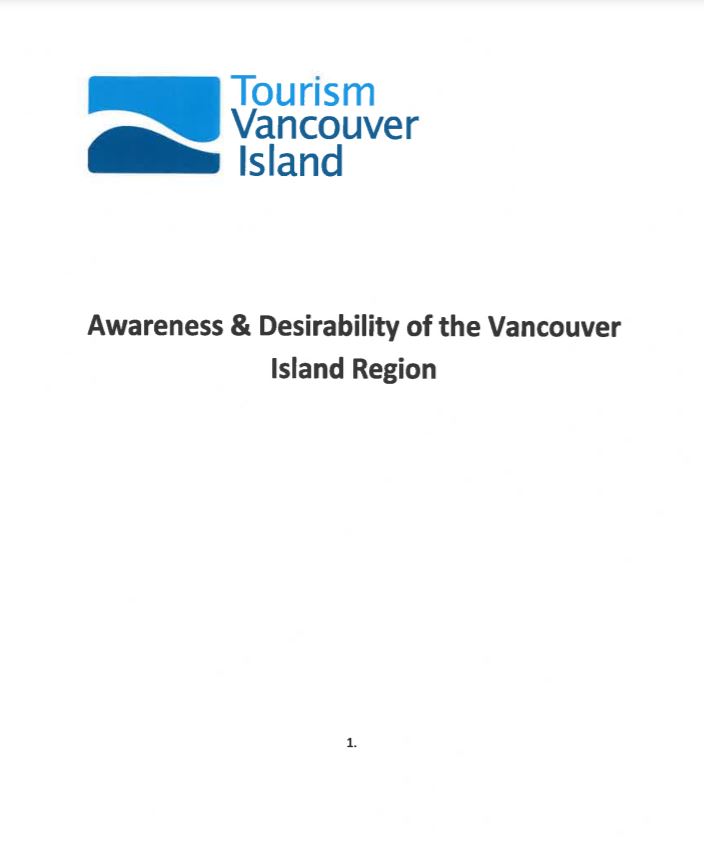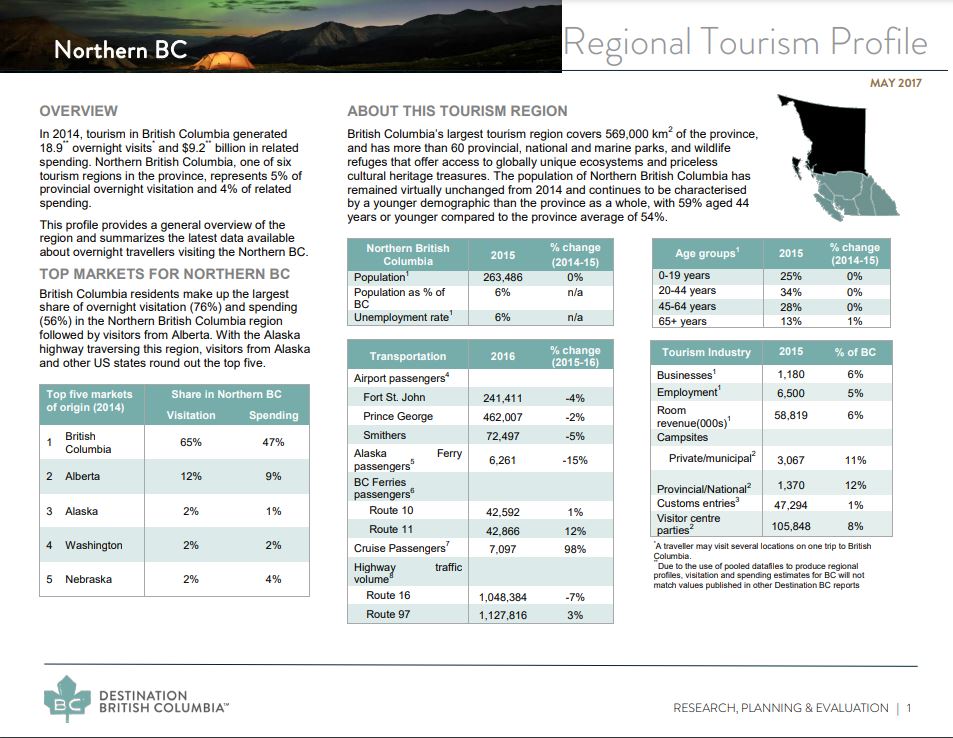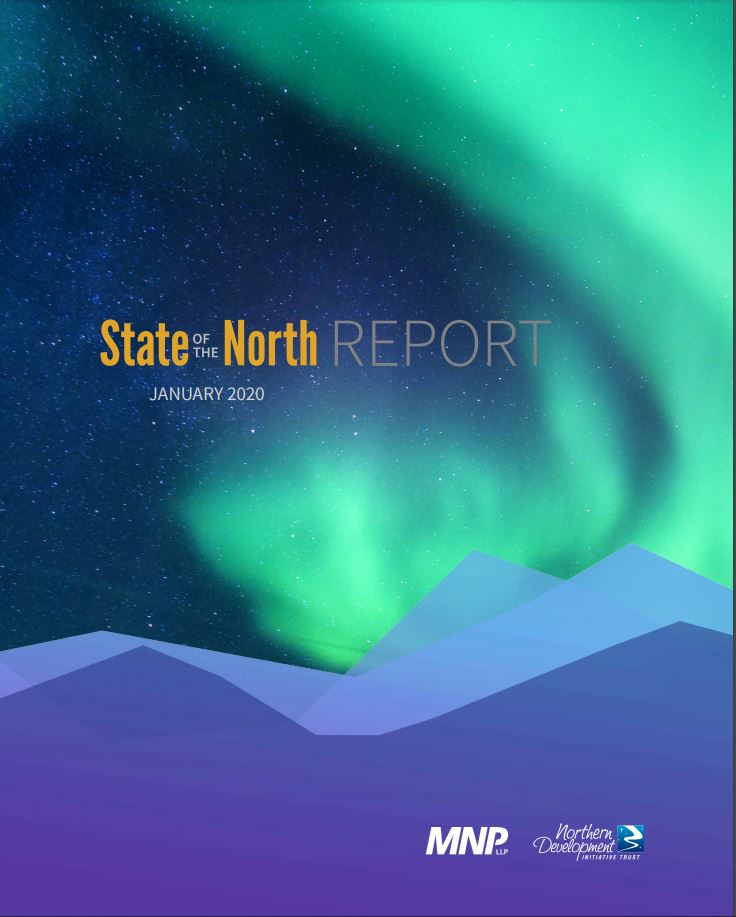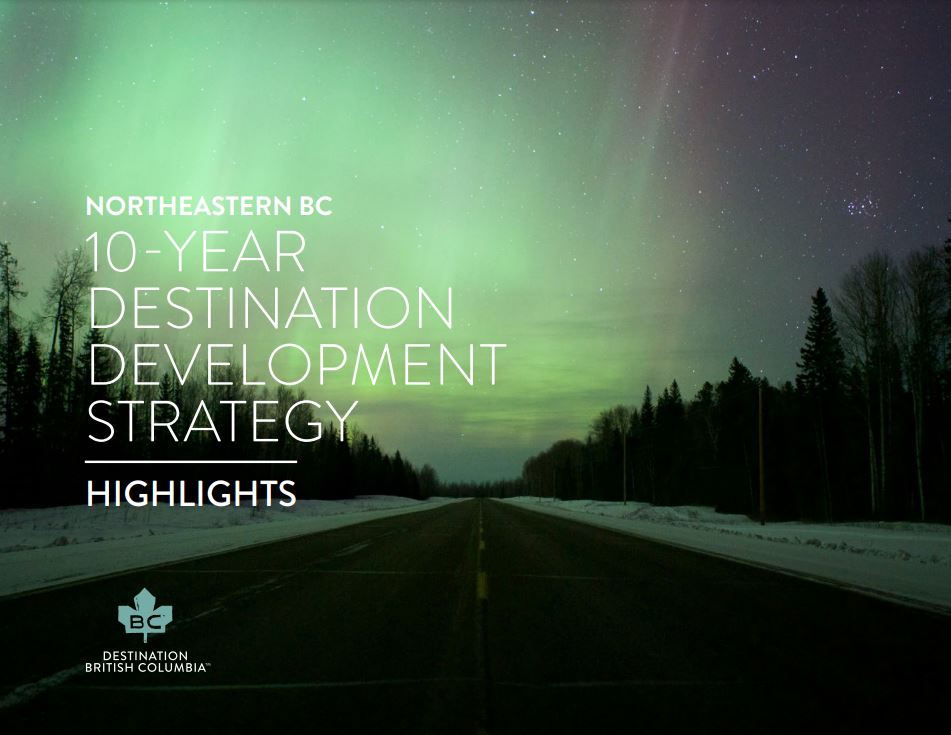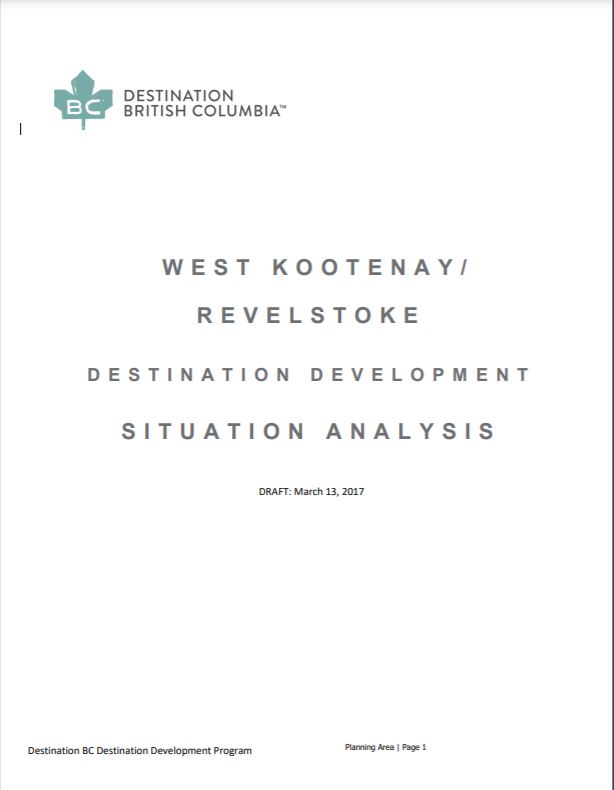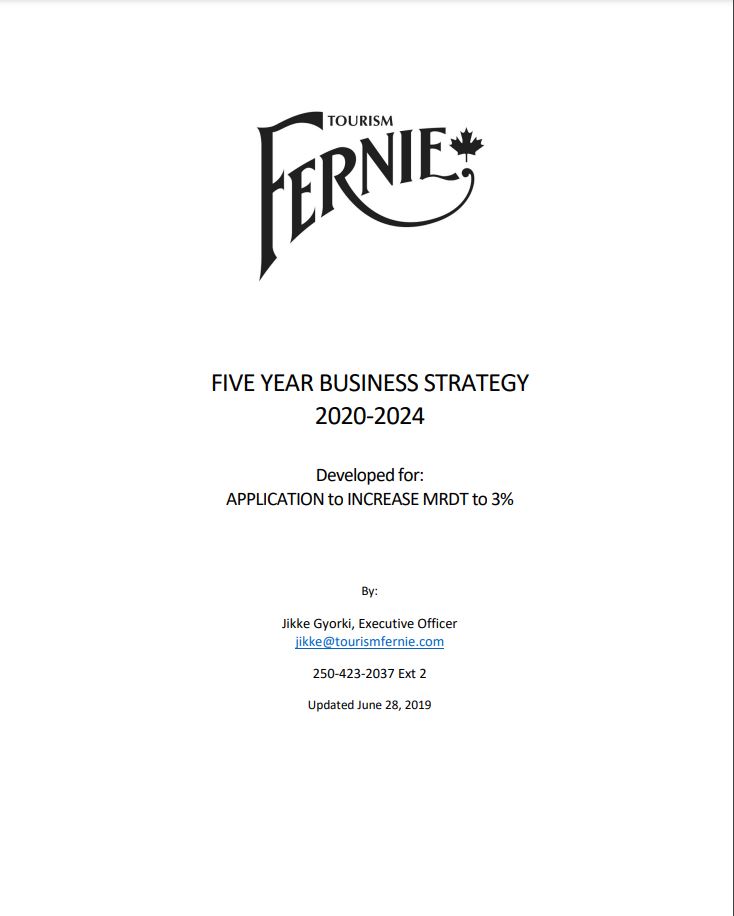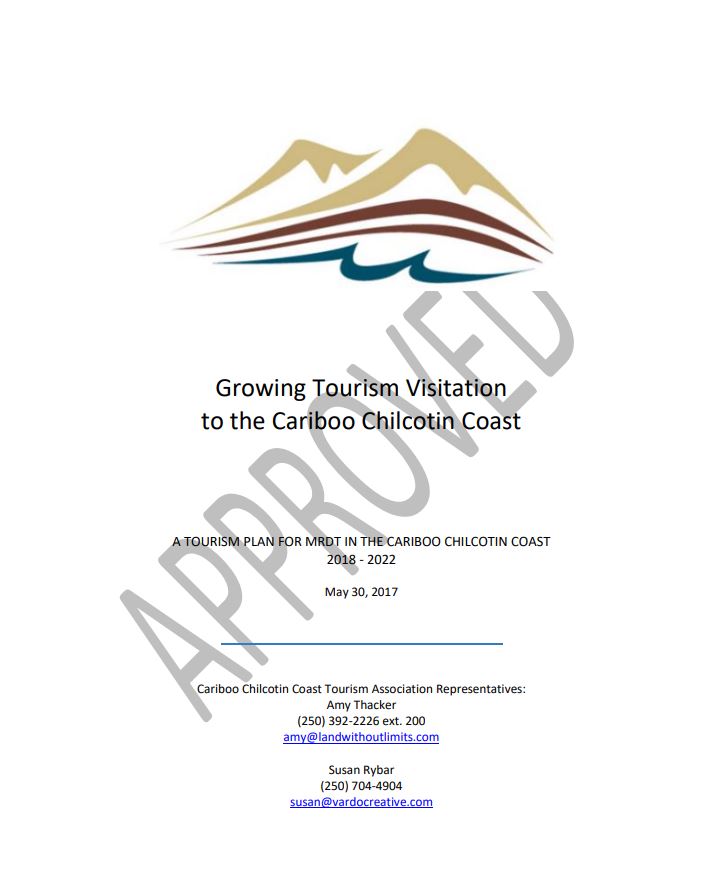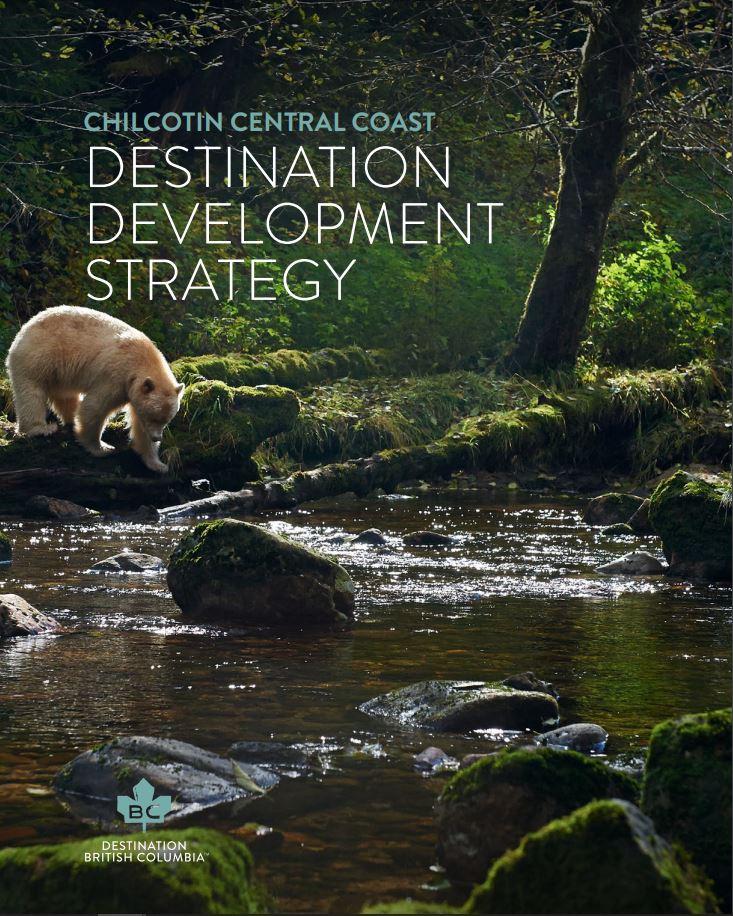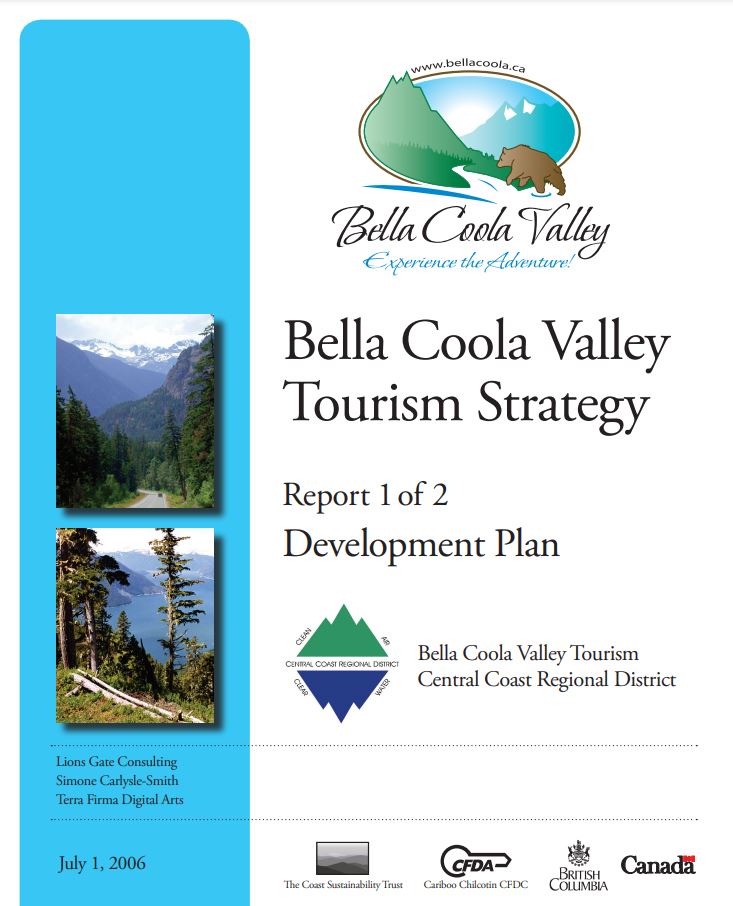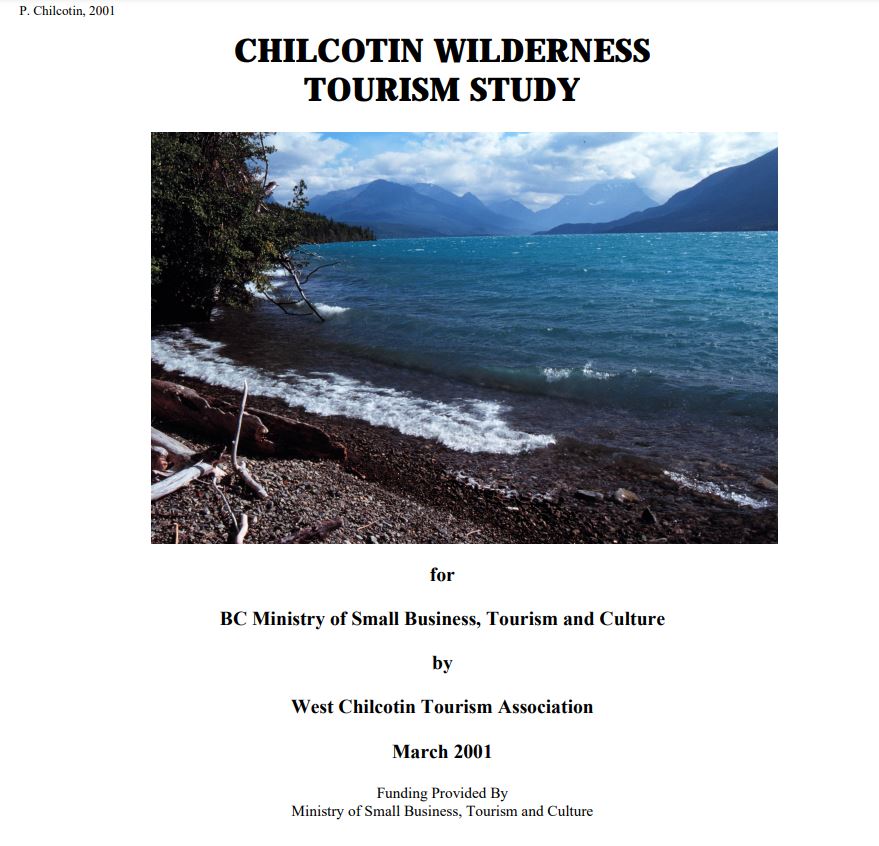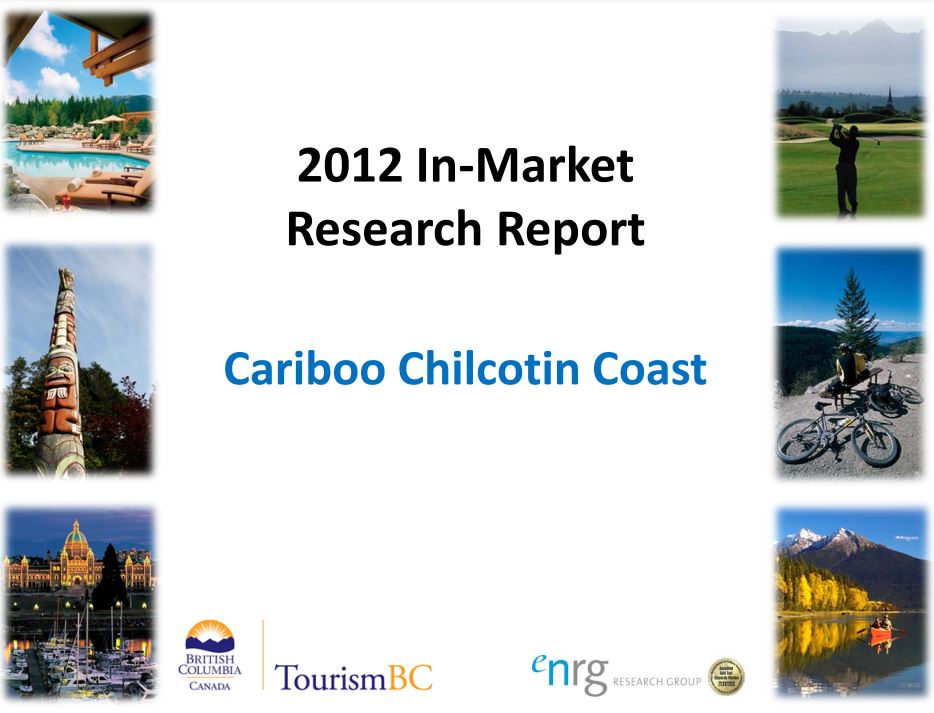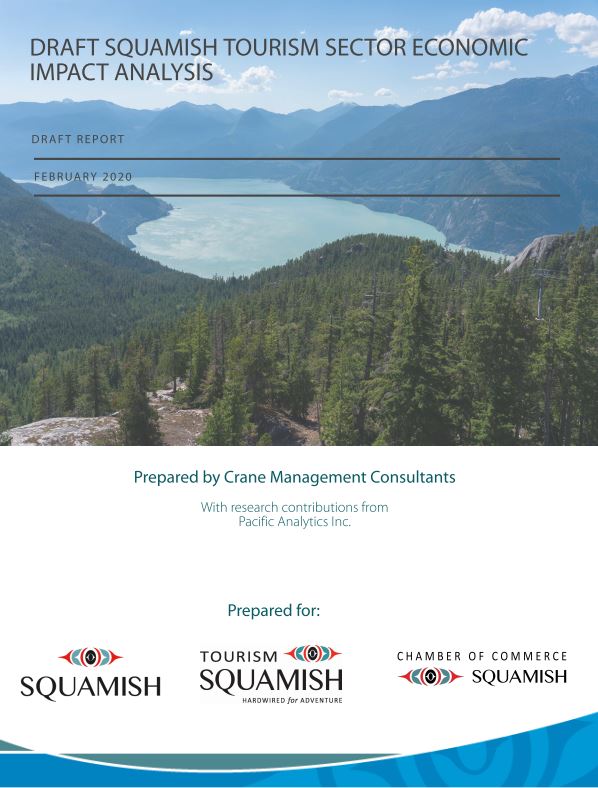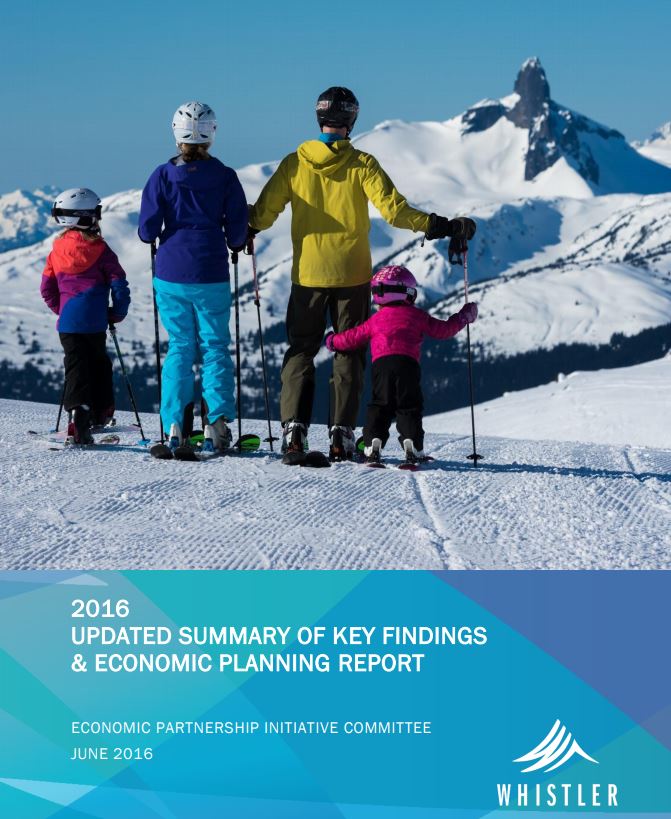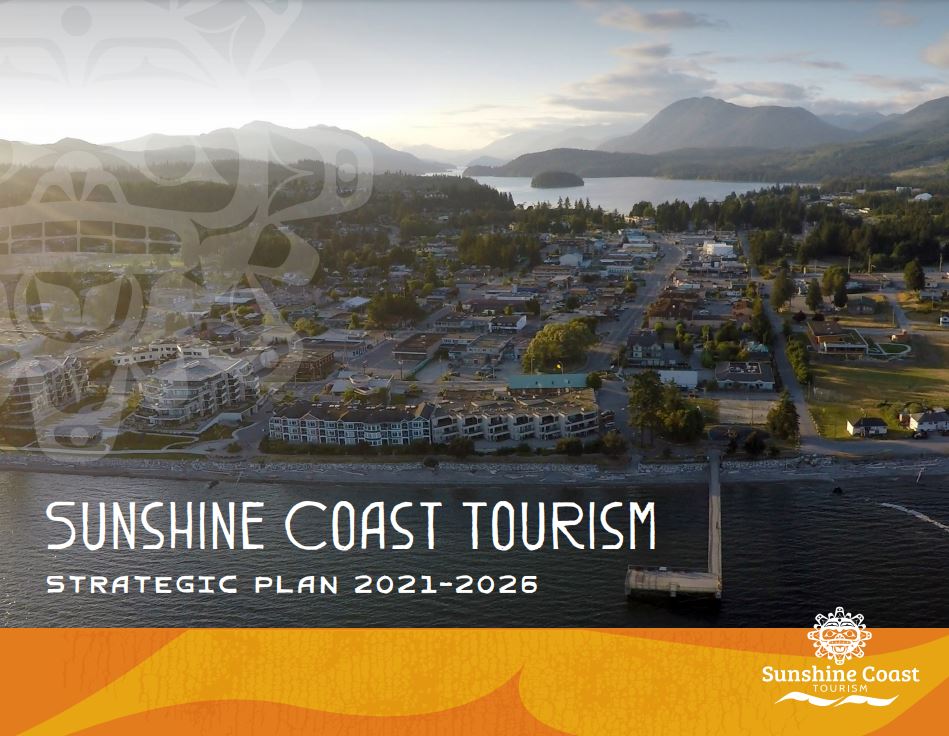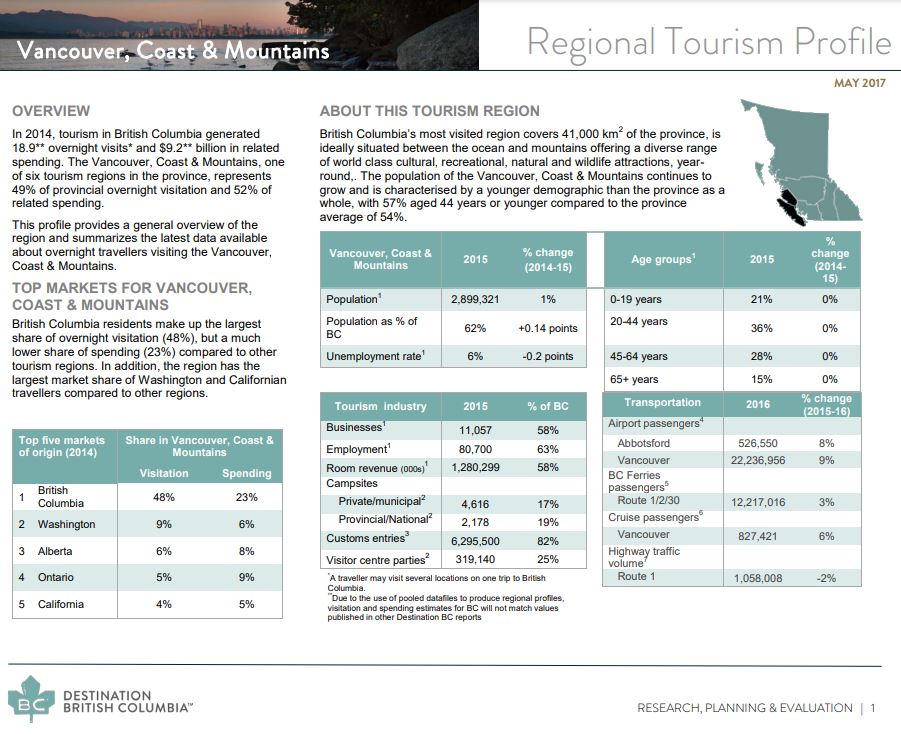Thompson Okanagan:
Since the formulation of the previous Penticton Destination Marketing Strategy in 2010, Tourism Penticton and the Penticton Hospitality Association (PHA) have worked independently to promote our region and during that time tourism has experienced a steady growth. The estimated economic impact of tourism in Penticton rose from $84.7 million in 2011 to $107.3 million in 2015.
Tourism is a major economic generator for the City of Kelowna and its surrounding municipalities and region. Tourism contributes directly to employment and economic growth in the region through the ongoing operations and activities of different firms that serve tourists. The tourism industry is a significant economic generator that makes contributions to the local economy, the Province of British Columbia and beyond.
This report summarizes key highlights for the Thompson Okanagan (TOTA) region taken from the British Columbia In-Market study conducted in November 2011 and April 2012. A full report on the findings, plus summaries of the other BC tourism regions are available under separate covers.
The Thompson Okanagan Tourism Association is actively monitoring the impact of COVID-19 on the tourism industry through our partnerships with the BC Regional Tourism Secretariat and the British Columbia Hotel Association
The Thompson Okanagan Tourism Association is actively monitoring the impact of COVID-19 on the tourism industry through our partnerships with the BC Regional Tourism Secretariat and the British Columbia Hotel Association
The Destination Osoyoos Business Plan has been developed through a combination of review of the previous five-year business plan which was developed in 2017 for our 2018 MRDT renewal, identification of industry trends, delivery of destination development workshops, and industry stakeholder consultation and engagement sessions. These activities took place between the fall of 2016 and the end of 2019. In addition, we have updated this document to reflect 2019 financial performance.
Vancouver Island:
Tourism is a major economic contributor to Greater Victoria. The tourism industry contributes directly to the employment and economic growth of the region through activities and operations of firms providing products and services to tourists, and is therefore a significant source of economic development for Greater Victoria, the province of British Columbia (BC), and beyond.
The Southern Gulf Islands Community Tourism Study is a broad-based study of tourism on the islands of Salt Spring, North Pender, South Pender, Galiano, Saturna and Mayne. This study is a joint effort by the Salt Spring Island Electoral Area and the Southern Gulf Islands Electoral Area of the Capital Regional District (CRD).
Given its size and proximity, Vancouver/Lower Mainland is an extremely important target market for the Victoria and Vancouver Island tourism sectors. Despite its vast potential, there is a sense among tourism industry experts that the Victoria/Vancouver Island tourism industry could be doing more to capitalize on the opportunity this significant market has to offer.
This profile provides a general overview of the region and summarizes the latest data available about overnight travellers visiting the Vancouver Island region.
This visitor profile was created for Vancouver Island North Tourism, in partnership with the local region and The Sociable Scientists. Between June and September 2018, twenty-five ballot boxes were placed across the region in businesses and operations that visitors frequent.
The Greater Victoria Destination Development Strategy (DDS) is a product of Destination BC’s (DBC) Destination Development Program (an integrated strategic planning process) co-led by Destination BC and Destination Greater Victoria.
The North Island Destination Development Strategy was developed to enhance the competitiveness of the planning area over the next 10 years and beyond.
The South Central Island planning area encompasses an exceptionally diverse range of landscapes and ecosystems; from rainforests, meadows, mountains and marshes, to beaches, rivers, lakes, and oceans. Spanning from the west coast of Vancouver Island to the inside passage, the planning area is comprised of three regional districts: Alberni-Clayoquot, Nanaimo and Cowichan, and the Southern Gulf Islands, and 24 First Nations.
This report represents the findings from omnibus telephone surveys of residents of British Columbia and Alberta conducted by Oraclepoll.
Northern:
This profile provides a general overview of the region and summarizes the latest data available about overnight travellers visiting the Northern BC.
The 2020 State of the North Report contains some startling new data regarding the health of the region, trends and growth into the future.
The region known as Northern British Columbia covers the northern half of the province from Highway 16 north to the Yukon border, and includes northwest BC, which is the focus of this report.
The Northeastern BC Destination Development Strategy is the outcome of a twenty-six month, iterative process of gathering, synthesizing, and validating information with tourism partners about the status and future direction of tourism in the Northeastern BC planning area.
The District of Fort St. James has identified the growth of the tourism sector as an economic development opportunity. Pursuant to a one-day workshop session held in March 2007 a Tourism Committee was formed to lead tourism planning and implementation.
The study was designed to provide information on the characteristics and volume of travellers to Prince Rupert and to support marketing plan design and product development in the Prince Rupert area.
Kootenay Rockies:
This Destination Development Strategy (DDS) is the result of a two year, iterative process of gathering, synthesizing, and validating information with partners and stakeholders about the current status, and future direction, of tourism in the Kootenay Rockies region.
Destination BC is offering destination development planning assistance to support the ongoing viability of BC’s tourism sector. The Destination Development Program (Program) is a critical part of Destination BC’s corporate strategy.
This Destination Tourism Plan is intended to provide a clear direction for tourism in Revelstoke over the next five years. It builds upon current tourism strengths, marketing trends, marketing research and key learnings from tourism activities and investments made by Tourism Revelstoke over the past five years.
Fernie is a small mountain town renowned for its spectacular setting within the Rocky Mountains, its place along the Elk River and for its world class skiing and recreation. A community of over 5,000 residents, Fernie is geographically located on Highway 3 in the Elk Valley of south eastern British Columbia and near the Alberta and USA border.
Tourism is recognised as one of the primary industries in Golden. With the 2019 Value of Tourism Study we were able to define for the first time a direct contribution of $124.5 million in revenues, representing 75% of gross business revenues, and 1,866 jobs that tourism provides to the local economy.
The Kootenay Rockies, one of six tourism regions in the province, represents 11% of provincial overnight visitation and 7% of related spending. This profile provides a general overview of the region and summarizes the latest data available about overnight travellers visiting the Kootenay Rockies.
Cariboo Chilcotin Coast:
The Cariboo Chilcotin Coast, one of six tourism regions in the province, represents 3% of provincial overnight visitation and 2% of related spending. This profile provides a general overview of the region and summarizes the latest data available about overnight travellers visiting the Cariboo Chilcotin Coast.
Tourism performance overall within the Cariboo Chilcotin Coast (CCCTA) tourism region is believed to have become relatively static, with consistent issues and opportunities but little significant leaps forward.
This Destination Development Strategy is the final report resulting from a 20-month, iterative process of gathering, synthesizing and validating information with stakeholders about the current status of tourism in the Chilcotin Central Coast.
Bella Coola Valley Tourism in association with the Central Coast Regional District has commissioned a consulting team led by Lions Gate Consulting to produce a Bella Coola Valley Tourism Strategy consisting of three major components: branding, development plan and marketing strategy.
The study objective is to complete a wilderness tourism study for the area with an emphasis on the Special Resource Development Zones located within the Chilcotin forest district area boundary.
This report summarizes key highlights for the Cariboo Chilcotin Coast (CCC) region taken from the British Columbia In-Market study conducted in November 2011 and April 2012.
Vancouver Coast Mountains:
Vancouver continues to rank as a top international destination based on its natural beauty, Indigenous culture, diversity, health and wellness, commitment to sustainability, gateway to the Pacific Rim, and integrated tourist infrastructure.
The Metro Vancouver Destination Development Strategy focuses on increasing the capacity for responsible tourism growth and ensuring the visitor experience is enhanced to better disperse visitors and spread the benefits of tourism to all communities.
This project was a joint initiative between the District of Squamish, Squamish Chamber of Commerce and Tourism Squamish to better understand the impact of the tourism industry in the Squamish area.
Whistler’s economy has strengthened over the past few years, with solid growth in guest visitation contributing to higher consumer spending in Whistler and subsequently, an increased contribution to both the local and provincial economy.
Building on the successful collaboration between the Sunshine Coast and qathet Regional Districts, the Sunshine Coast Tourism Strategic Plan 2021-2026 will continue to advance the destination development and tourism aspirations of the region.
This profile provides a general overview of the region and summarizes the latest data available about overnight travellers visiting the Vancouver, Coast & Mountains.

